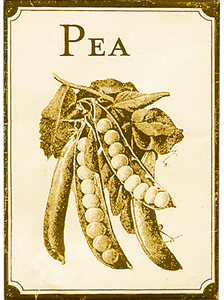PEA
Vitals
• Pisum sativum humile , belonging to the legume family, Fabaceae/Leguminosae.
• Exact origin unknown, though concentrations of wild peas are found from the Mediterranean rim into Central Asia.
• Early archeological evidence: Peas found in Iraq and Turkey date back to 7500 BC.
• Early literary reference: Apicius, a Roman cookbook author, has nine recipes that include peas.
• Earliest cultivation: Hybridized peas found in Turkey date back to 5750 BC.
• Evidence of later cultivation in other areas: Greece, 5500 BC; Bulgaria, 4330 BC; Nile Delta, 5000 BC; Rhine Valley, 4300 BC; India, 2000 BC; China AD 600–900.
• Climate: Cool (below 80 °F; 26 °C) Mediterranean climate.
• Major producing countries: United States, England, Hungary, India.
Short history
Pease porridge hot,
Pease porridge cold,
Pease porridge in the pot,
Nine days old.
By modern standards, nine days is a ripe old age for cooked peas. But this well-known rhyme is a testament to what a staple peas were during the Middle Ages in Europe. Peas are one of the earliest known plant crops, and they were present during the spread of agriculture in Europe during the Neolithic period. Because dried peas will last for many months, it was easy for travelers to transport them around the world. Dried peas also kept families fed with nutritious stews through the winter.
Peas were the famous subjects in the genetic experiments of Gregor
Mendel, the nineteenth-century Austrian monk who showed that there
are patterns of inheritance between generations. You can read more
about his experiments here:
http://anthro.palomar.edu/mendel/mendel_1.htm
You can see an animation of Mendel’s experiments at the Mendel Museum Web site .
Pea facts and loreDon’t turn your nose up at frozen peas! They’re often sweeter than fresh peas at the market, having been frozen almost immediately after harvesting.
Peas aren’t often on the menu at upscale restaurants: Their rolling nature can mean challenges to table manners, as diners try to skewer peas with their forks and keep them from rolling off the edge of the table.
In a famous fairy tale, “The Princess and the Pea,” a young princess proves her lineage when a pea slipped under a stack of 20 mattresses keeps her tossing and turning all night.
See a pea pod (the fruit) develop from a fruit to a flower .
Saving the seedPeas are among the easiest plants to save seed from and grow the next season.
• If you’re growing more than one pea variety in your garden, they should be separated by at least 50 feet.
• Decide which of your pea plants you think has the best traits: most peas in the pod, biggest peas, most pods, and so forth.
• DON’T EAT ALL THE PEAS FROM THE BEST PLANT! Yes, you’ll have to resist temptation. These peas will become your seeds.
• Keep the pods on the plant until they are dry and brown, about four weeks after harvesting stage. If the weather is frosty, pull up the whole plant, including the roots, and hang it in a cool, dry location until the pods are brown.
• Open the pods and remove the dried peas. Store them in a cool, dry place away from light until you're ready to plant them.
Note: Make sure that the pea plants you are saving seed from are what’s called an “open-pollinating” rather than a hybrid variety. For a list of companies that sell seeds for open-pollinating plants, and more information on the importance of seed saving, see our article Why Save Seeds?
